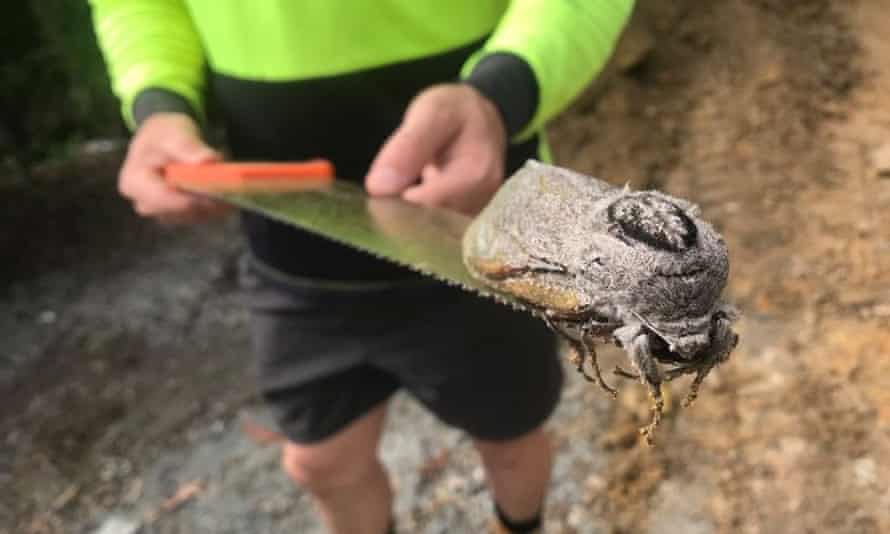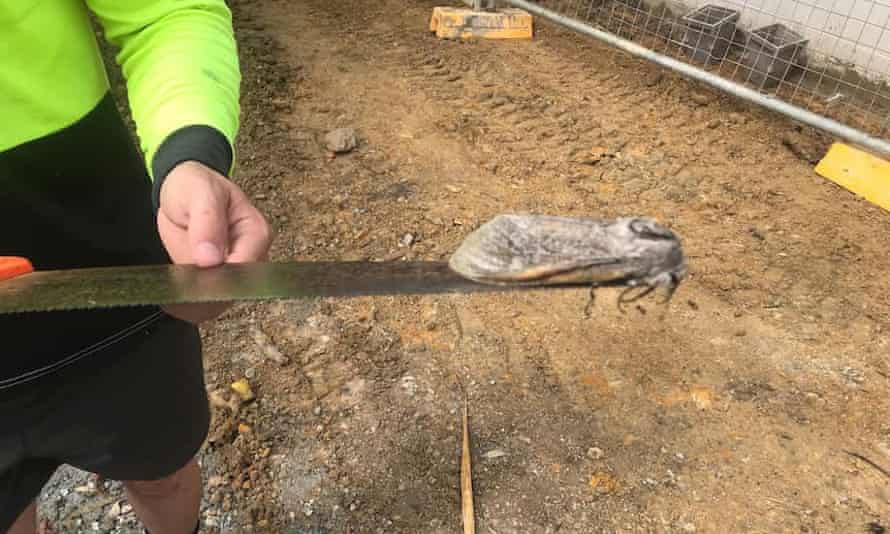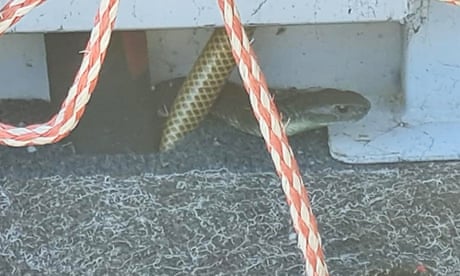Mammoth moth which can have 25cm wingspan found by builders working on Queensland primary school

A giant wood moth was found at Mount Cotton state school in Queensland by builders. While not uncommon they are rarely seen by humans in Australia. Photograph: Mount Cotton state school/Facebook
Lisa Cox
Wed 5 May 2021
A giant moth with a wingspan measuring up to 25cm has been found at a Queensland school next to a rainforest.
Builders found the giant wood moth, the heaviest moth in the world, while constructing new classrooms at Mount Cotton state school.
Giant wood moths are found along the Queensland and New South Wales coast, according to the Queensland Museum. Females can weigh up to 30 grams and have a wingspan of up to 25cm. Males are half that size.
They have an extremely short life cycle with adults living only a matter of days. They die after mating and laying eggs.

Scientists sound alarm about Australia’s 26 most endangered butterflies
Read more
The school’s principal, Meagan Steward, said the moth was “an amazing find”.
Steward said due to the school’s location it was not unusual to find a range of animals on the grounds such as bush turkeys, wallabies, koalas, ducks, the occasional snake and once a turtle in the library. “A giant wood moth was not something we had seen before,” she said on Wednesday.

Lisa Cox
Wed 5 May 2021
A giant moth with a wingspan measuring up to 25cm has been found at a Queensland school next to a rainforest.
Builders found the giant wood moth, the heaviest moth in the world, while constructing new classrooms at Mount Cotton state school.
Giant wood moths are found along the Queensland and New South Wales coast, according to the Queensland Museum. Females can weigh up to 30 grams and have a wingspan of up to 25cm. Males are half that size.
They have an extremely short life cycle with adults living only a matter of days. They die after mating and laying eggs.

Scientists sound alarm about Australia’s 26 most endangered butterflies
Read more
The school’s principal, Meagan Steward, said the moth was “an amazing find”.
Steward said due to the school’s location it was not unusual to find a range of animals on the grounds such as bush turkeys, wallabies, koalas, ducks, the occasional snake and once a turtle in the library. “A giant wood moth was not something we had seen before,” she said on Wednesday.

Giant wood moths are found along the Queensland and NSW coast. Females can weigh up to 30 grams and have a wingspan of up to 25cm. Photograph: Mount Cotton state school/Facebook
The initial ABC news report and photos of the moth generated so much media interest the school was forced to direct questions about the moth to the Queensland education department.
Chris Lambkin, the curator of entomology at the Queensland Museum, said giant wood moths, or Endoxyla cinera, could be found from coastal Queensland down to southern NSW. While not uncommon they were rarely seen by humans, she said.
Lambkin said this was likely due to several factors including the adult moths’ short life span and the fact most people lived in urban areas where the invertebrate was not found.
“The female moths also don’t fly very well,” she said.
“So most people, if they do see one, it has emerged as an adult and crawled up a tree trunk or a fence post and is waiting for the male to come along. Normally people don’t see them with their wings spread out so you don’t realise just how big they are but if you actually lift them up they’re very heavy.”
As small caterpillars, the invertebrates have purple and white banding and bore into the trunks of smooth-barked eucalypts in parks and gardens. They lose the banding as they grow into larger grubs.

‘Certainly life-threatening’: 80-year-old Australian survives 30-minute boat ride with tiger snake
Lambkin said the adult female moths don’t feed and live on fats stored as larvae while feeding inside the tree trunk.
“The first time we see them is when they’re over 2.5cm long and thick as a lead pencil,” she said.
The entomologist said little was known about the first year of the larval stage, which lasts for about three years. The adult female moths can be up to 15cm long.
There are about 60 species of wood moth in Australia, according to the Queensland Museum, but not all are as large as the giant wood moth and not all feed on eucalypts.
The builders took a photo of their find before returning the moth to the rainforest.
The year 4-5 class in the new building was asked to develop a creative writing concept after being shown a picture of the moth and decided to write about a moth invasion. “The students wrote some very creative, imaginative pieces of writing – including Mrs Wilson getting eaten by the giant wood moth,” Steward said.
The initial ABC news report and photos of the moth generated so much media interest the school was forced to direct questions about the moth to the Queensland education department.
Chris Lambkin, the curator of entomology at the Queensland Museum, said giant wood moths, or Endoxyla cinera, could be found from coastal Queensland down to southern NSW. While not uncommon they were rarely seen by humans, she said.
Lambkin said this was likely due to several factors including the adult moths’ short life span and the fact most people lived in urban areas where the invertebrate was not found.
“The female moths also don’t fly very well,” she said.
“So most people, if they do see one, it has emerged as an adult and crawled up a tree trunk or a fence post and is waiting for the male to come along. Normally people don’t see them with their wings spread out so you don’t realise just how big they are but if you actually lift them up they’re very heavy.”
As small caterpillars, the invertebrates have purple and white banding and bore into the trunks of smooth-barked eucalypts in parks and gardens. They lose the banding as they grow into larger grubs.

‘Certainly life-threatening’: 80-year-old Australian survives 30-minute boat ride with tiger snake
Lambkin said the adult female moths don’t feed and live on fats stored as larvae while feeding inside the tree trunk.
“The first time we see them is when they’re over 2.5cm long and thick as a lead pencil,” she said.
The entomologist said little was known about the first year of the larval stage, which lasts for about three years. The adult female moths can be up to 15cm long.
There are about 60 species of wood moth in Australia, according to the Queensland Museum, but not all are as large as the giant wood moth and not all feed on eucalypts.
The builders took a photo of their find before returning the moth to the rainforest.
The year 4-5 class in the new building was asked to develop a creative writing concept after being shown a picture of the moth and decided to write about a moth invasion. “The students wrote some very creative, imaginative pieces of writing – including Mrs Wilson getting eaten by the giant wood moth,” Steward said.
No comments:
Post a Comment